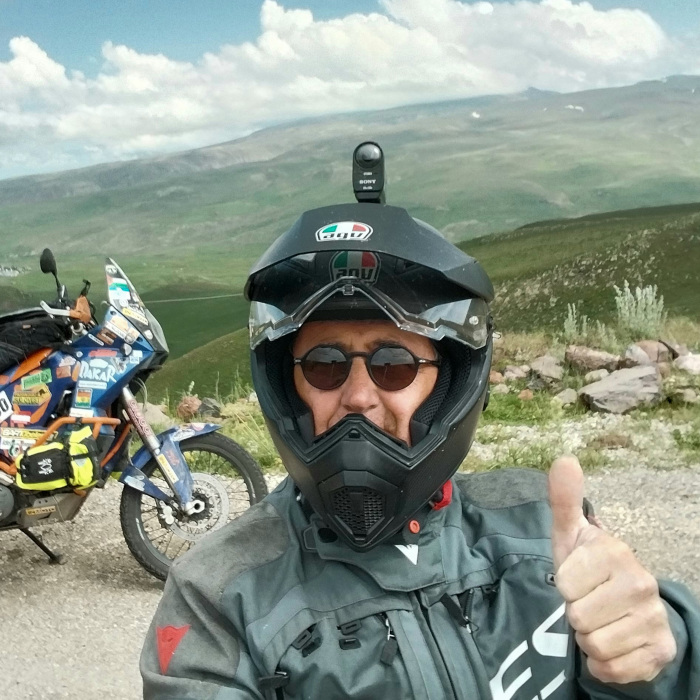
I was born in 1959 and I’ve been traveling around the world on a motorcycle for over 40 years. I’ve traveled more than 1,200,000 km and been on every continent. Lots of people think I’m courageous, but I always reply that I’m GP, a man with passion in him, who has built up some great experience. You can reach any place in the world, if you don’t run into politically unstable situations or bureaucracy, as happened to me this time. I still travel with maps. I don’t know what GPS is – I use the one in my brain, as a friend told me years ago. The great thing is to really lose yourself on the roads of the world.
The first part of my motorbike trip along the Silk Road can be found here: The Silk Road by Motorcycle - from Italy to Georgia
I left Italy with my KTM 990 Adventure and I’m on the road heading for Mongolia. I’ve already crossed Albania, Macedonia, Turkey, Iraq, Turkey again, Georgia, Armenia, then I should have crossed the border into Azerbaijan but I found the border closed. Now I’m dealing with customs to get into Russia.
Early in the morning, I summon a great supply of patience. The international situation is what it is. I expect there will be trouble at the Russian border. They check everything on me, then when the bike needs to be registered it turns into a lottery to see who is smartest. The Russians present their passports with the rubles inside. Five of them pass ahead of me, then I put on my “madman” act and raise my voice at the person behind the glass. She tells me several times that they only speak Russian there. I obviously speak in English and point out the colleague who checked my bags, who speaks fluent English. She comes over and I tell her that it’s my turn and that I don’t want to pay a single ruble because I don’t have to pay anyone. 10 minutes pass and I’m finally given the documents. However, three hours have passed, and I learn that the day before an Italian guy and some Germans waited as long as nine.
I make a calculation and decide to go to Groznyj, Chechnya, as infamous as it is quiet. I cross it – the Russian population has been replaced by Muslims. A group of guys at the gas station ask me for a photo together. No sooner said than done. Another 150 km and I’m in Daghastan, another Islamic state of the Russian Federation on the Caspian Sea. It’s night when I enter Astrakhan, but I’ve put 650 km behind me and I sink into bed.
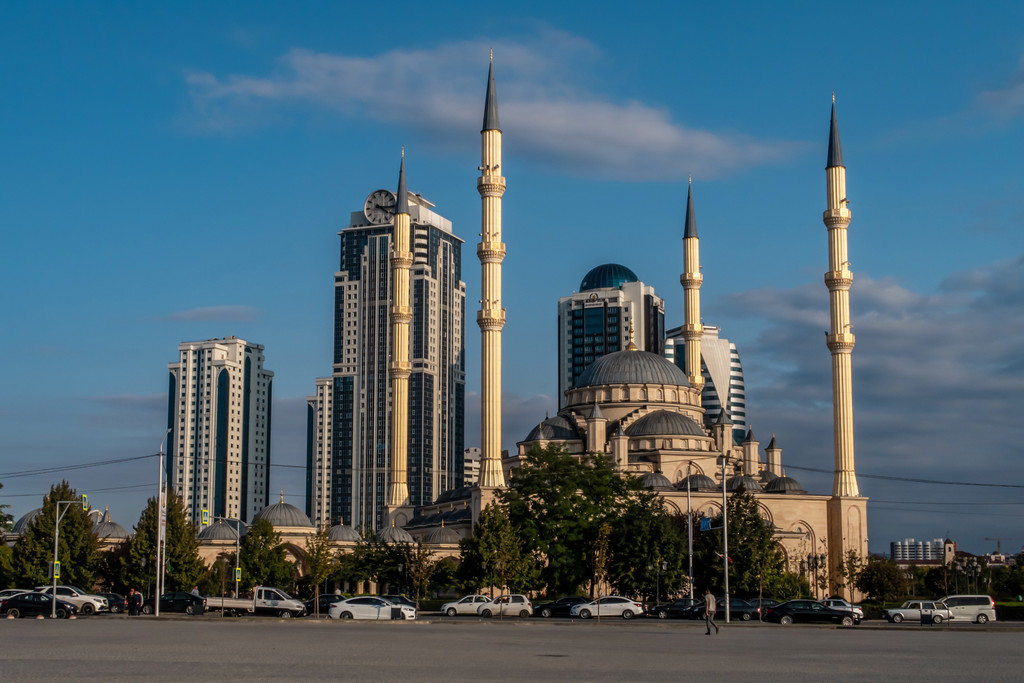
In the morning I load the motorbike with difficulty, knowing what awaits me once I cross the Volga river on sheet metal rafts. Another 30 km and I find myself at the border with Kazakhstan. The formalities don’t last long, also because the motorbike doesn’t have to go through customs, given the interchange with Russia. The road leading to Atyrau is under construction. Compared to five years ago, there’s a long stretch with asphalt. When it ends you travel alongside – dust, trucks to overtake and even a sandstorm for good measure. My friend Aidos is waiting for me at the hotel. It’s a shower then dinner together in a typical restaurant reminiscent of Mongolia. The Kazakhs resemble the Mongolians in every way, including their traditions, but when he suggests I drink camel’s milk I politely decline. I can’t stand the sourness.
We’re saying goodbye to my friend. It’s time to continue the journey south to Beyneu. I pass Kulsary. After a few kilometers I find myself observing a horrifying real-time situation from afar. A head-on collision between two cars. A car ends up off the road and fire breaks out. The people who get there try to tame it, then get the people out. Of the eight people in the two cars, seven have died. The only survivor has a swollen face. I get out my first aid kit and try to treat his wound. I’m a tough guy but faced with this scene I struggle to get back on the bike. It’s not easy – I have a thousand thoughts swarming in my head and you can’t afford to have it elsewhere.
In Beyneu I know where to sleep – it’s the third time I’ve been here. Waking at dawn, the border is 70 km away. Now it’s all asphalt. the same can’t be said for the Uzbek side, where I find terrible off-road. It’s raining and it’s a slalom between potholes. A truck swerves so it ends up in front of me. I lean right and the front wheel goes into the mud. I end up horizontal. It’s no big deal. It was at low speed, but I’m all muddy. I sleep in Nukus. Luckily there’s a beautiful sun waiting for me the next day. A couple of hours of travel and I park in the center of Khiva, one of the legendary cities on the Silk Road. I park my KTM and allow myself to be a tourist for a couple of days.
Now the climate is dry. I’m in the middle of a desert, Kizilkum, shared with Turkmenistan. I set off from Khiva, skirt the border then cross the Amudaria, the longest river in Asia which originates in Afghanistan. I do it on a bridge of battered rafts; some lower the metal sheets with a hammer, some try to weld them together – what a laugh. When I arrive in Bukhara, I struggle to remember where to sleep. A series of restrictions have changed the road system and moving with a loaded motorbike becomes a lottery, but I don’t give up.
The Kalan Minaret was once the tallest building in Central Asia. Tamerlane spared it from destruction, actually taking inspiration from it to build the Registan of Samarkand, which I reach after another two days. Here, tourism reigns supreme. In the evening, lights and sounds come into play that have nothing to do with the quiet of the previous sunny days. The first time I set wheels here was the year 2000. Now, I’ve come to Samarkand five times and honestly I have a lot of trouble recognizing it. Now you pay for a ticket to enter the Registan. In the evening the avenues are ridden with battery-powered vehicles that dart about at full tilt, as if a prize was up for grabs.
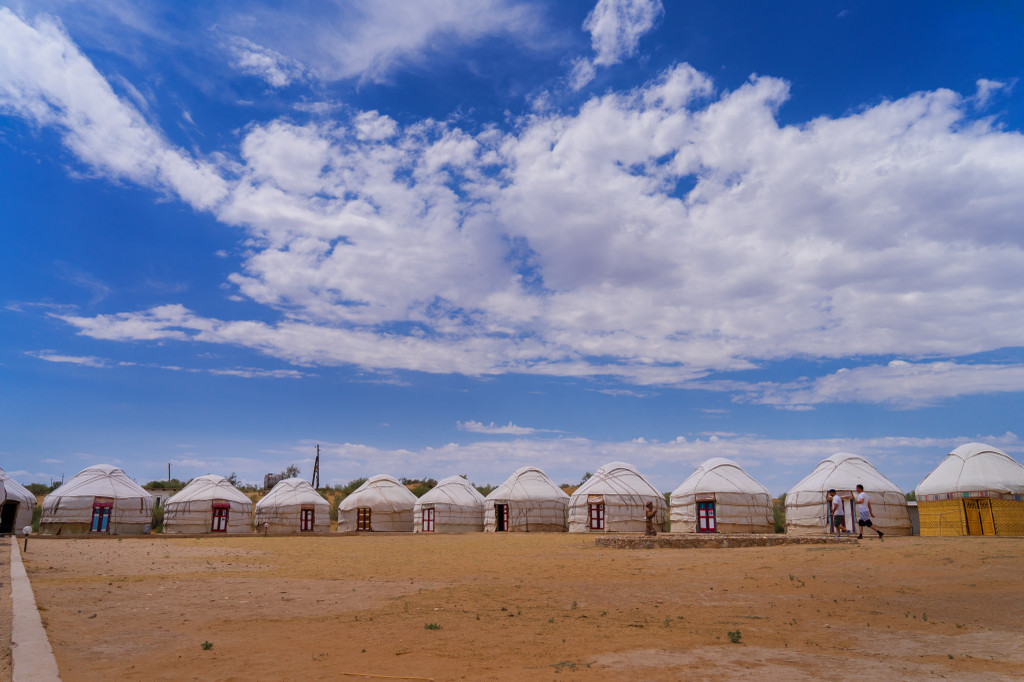
I hold out for days, one of which I dedicate to motorcycle maintenance. I change oil and filter. I have everything with me. Then I leave my luggage and for three days I enter the Fergana Valley, one of the most lush areas of Uzbekistan. Once back in Samarkand I have an afternoon to organize myself. Tomorrow I enter Tajikistan – another round, another state, and we’re at 11.
Waking at 7, I load the motorbike, have breakfast and set off, fill up at the gas station and head towards the border. I’m in line to get my passport stamped. The policeman at the counter, passport in hand, asks me for my phone. Him in Russian, me in English, a dialogue of the deaf. Luckily a gentleman behind me speaks English and kindly steps forward to interpret. He wants the phone to take a photo on the PC – I don’t understand. The gentleman tells me that I have to go into the office next door where the bank is. But I don’t have to change money, no, I have to pay three speeding fines! I acquiesce and pay a total of 42 euros. Tajikistan offices...
Twenty minutes and I’m outside the border. All I have to do is get to Dushanbe, the capital of Tajikistan. It’s Sunday and there’s no traffic. I find myself sleeping in a police motel – at least I’m safe. On Monday I get my thoughts in order and buy a local SIM. I have 2 possible roads to Kaylakum, one short crossing the mountains, the other longer but asphalted and fast. I opt for the latter. I have 10,000 km behind me and the tires are almost worn out, especially the back one.
I skirt the border with Afghanistan, at times just 500 meters away from it. I arrive in Kaylakum, fill up with gas then head straight to the hotel. In the capital I was told that I’d have problems on the road going to Khorog. I know the Pamir. It’s my third time here. It crosses valleys at over 4,000 meters. They’re doing some work to fix it, with Chinese companies. The only window to travel it is from 3 to 7 AM. After that the affected section stays closed, only opening at noon for lunch.
At 3 AM I’m on the road… well, off-road in fact. I overtake a truck in the middle of a cloud of dust; I feel a bump at the back, maybe a stone. One kilometer on and my rear tire is flat. No worries – I have everything I need to repair a tubeless. But it’s a death blow – a piece of iron made a nice clean cut in my tire. I put the inserts, plural, in the hole, and inflate it. It seems to hold up. I set off again. In the meantime, daylight arrives. 50 km and I’m back to square one. Now there are two holes. I close them again. I get to the checkpoint late, but the tire holds up. That’s important. After about 200 kilometers I find the asphalt again. What a relief. I don’t have the time to think it and I’ve got a flat tire again. I could have really done without this. I open the workshop, take everything down including all the baggage, remove the wheel, remove the tire and fit the inner tube.
I arrive in Khorog very tired, so much that I decide to rest for two whole days. In a shop I buy more ‘corks’, as I call them, for the tubeless tire, but I’m not convinced that there are enough. The slit is getting bigger and bigger. I look for an inner tube, too, just to be safe, but there isn’t so much as a whiff of a size anything like what I need.
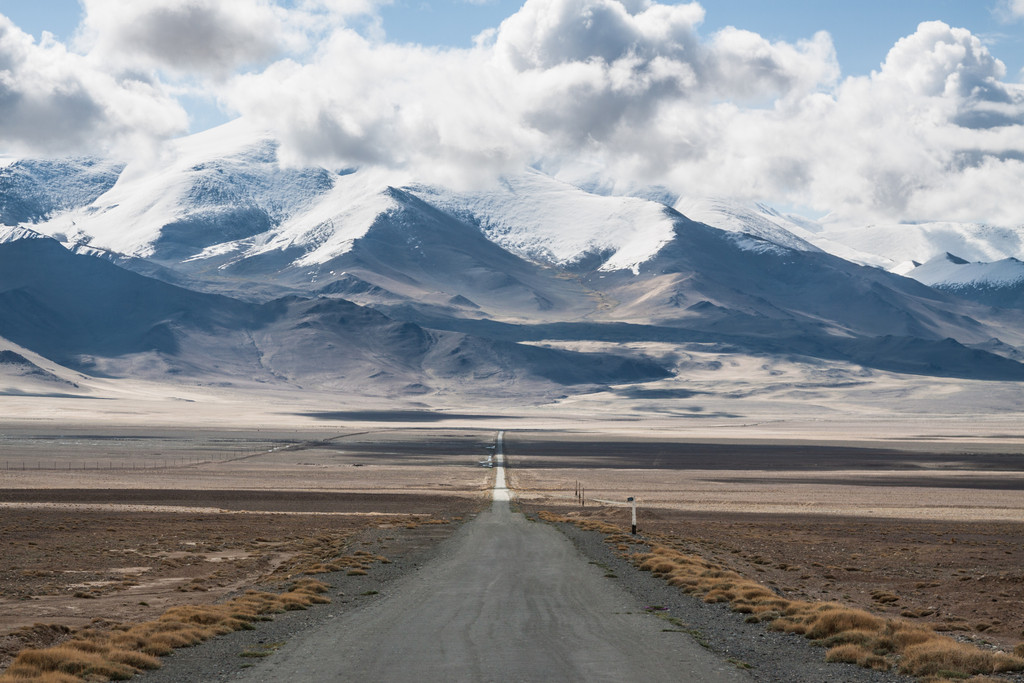
Now I have two roads ahead of me – I can choose whether to head south along the border with Afghanistan and cross various villages, all off-road, or go straight east along the legendary M41 up to Murghob. But there’s another dilemma that has been animating the web for days, the closed border at the 4,200-meter Kyzylart pass. For months there have been tensions between the two states, over around 800 km of borders that were never clearly defined, a legacy of the old Soviet Union.
In Dushanbe I’d had an idea based on my previous experience. I’d searched for the website of the Kyrgyz Ministry of Tourism. I’d sent an email, and when I switch on the PC in Khorog, I find the reply – all I need to do is send a photo of my passport and of myself. They’ll advise the border of my arrival and I’ll be authorized to cross. The guys in the hotel ask me where I’m going. Kyrgyzstan, I say, and they say, “But you can’t cross.” I show them the reply with a certain satisfaction and the grapevine springs into action – I’m drowned in thanks. Old GP always finds the answer! And the tire? I decide not to think about it.
So I proceed along the M41, the Pamir Road. Little villages, then a couple of passes at over 4,500 meters. I can feel it through the bike, on which the power drops noticeably. In the evening I’m in Murghob, where I meet Enrico from Lecce. We don’t know each other, but since he contacted me and understood that there’s a way to cross the border, he decided he wanted to meet me.
I get gas from the usual station with cans. It’s only 83-octane but I’ve got an additive. I find myself with Enrico. He sleeps elsewhere while I head to where I slept 15 years ago, a bed and breakfast on the hill. I park. I recognize the lady, the owner, who speaks excellent English. I don’t say anything, but when she brings me dinner she asks if I’ve been here before. I answer in the affirmative and she says, “Yes, 15 years ago.” Exactly! There was me, an Englishman and two German guys, all on motorbikes. On that occasion I came from Pakistan.
In the morning I meet with Enrico. Together, we head for the border. You go up and down, along the Chinese border, with kilometers of barbed wire as a barrier. Then, down there at the end, Lake Karakul, sharing its name with the one on the other side in Chinese territory. This one was created by a meteorite that fell 10,000 years ago. From here to the border, it’s very windy, and since not even the locals pass through, the road is absolutely in pieces. At the border, Enrico can’t find the motorbike’s entry form. I distance myself – if a few dollars need to change hands, there’s no need for witnesses.
I cross the border and hurtle along the dirt road to the Kyrgyz one. It’s nothing like the one in Tajik. Now, five years later, they’ve built a new one. I’m on the other side of the gate and they ask me for my passport. The English-speaking commander arrives and asks me if I’ve applied for authorization. “Of course,” I reply. After a while they let me through for registration. The motorbike stays on the other side of the gate. Enrico arrives, too. My name’s on the list but Enrico’s isn’t. He applied later, and isn’t registered yet. I go, and he keeps waiting. There’s a building where he’ll pitch a tent. We’re at over 3,000 meters and it’s cold. 30 km separate me from Sary-Tash, a crossroads for China.
The next morning I have omelets, cookies, water, cold cuts and bread prepared. I go back towards the border. Enrico will have to wait for Monday. Today is Saturday, and up there you can’t find anything at all. I arrive at the gate and the soldier calls the commander, who appreciates the gesture. He has me cross the border to deliver the food to Enrico personally. I return to Sary-Tash, fill up and head for Osh, where I arrive in the early afternoon. I check the tire. I could find a replacement here, but it’s not far to Almaty, 900 km.
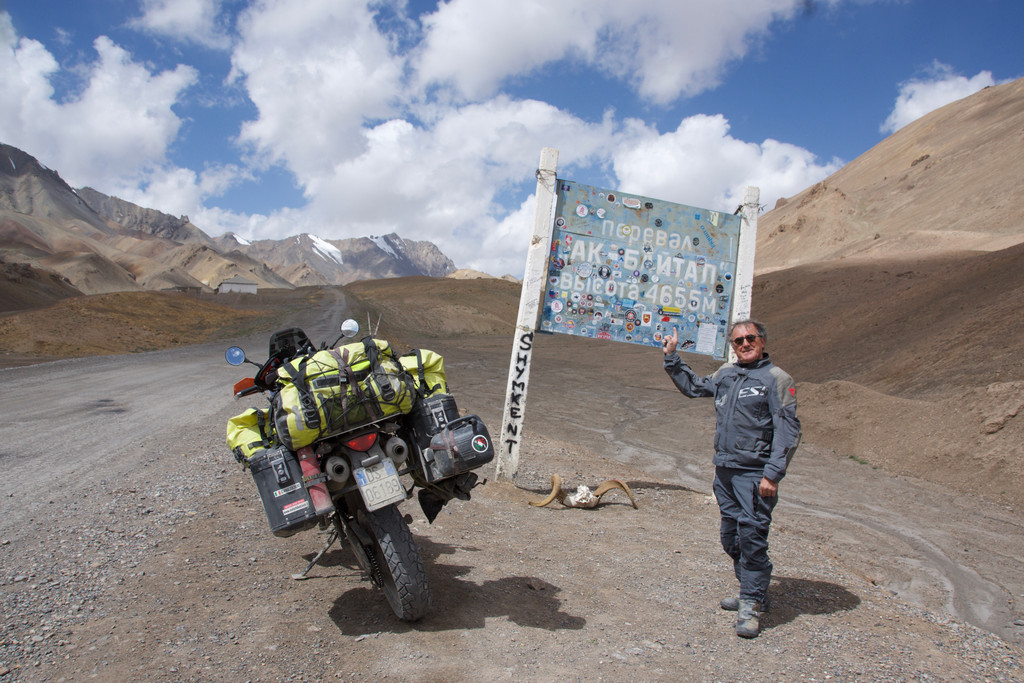
I ride in the middle of the mountains, among breathtaking views. 300 km before Biskhek, the capital of Kyrgyzstan, l find myself with a flat tire again. I’ve punctured the inner tube. I open the kit I bought in Khorog but the adhesive is no good. They slipped me an old pack, but I don’t give up. I’ve got Attak. I try to glue it and luckily the patch holds.
In the evening I sleep in a tent and the next day I finally stop at a tire shop, even if it isn’t equipped with a new tire. I can’t remember how many times I’ve removed the wheel anymore. He puts another patch on the inner tube, but it’s the cut that’s gotten bigger. It’s sink or swim. I’m in the world now. Worst case scenario, I’ll load it onto some emergency vehicle. I arrive in Biskhek, the capital of Kyrgyzstan and the rear wheel plays a strange trick on me. This time it’s the worn bearing’s fault but… I have my friend Giuseppe who runs a restaurant here. I feel at home. First thing, in the evening, I have a nice first and second course of Italian cuisine. You think better on a full stomach.
In the morning I take the wheel down and with Giuseppe’s help we fix the bearing. Now I have 235 kilometers to go to Almaty. I cross the umpteenth border, but 25 kilometers from the former capital of Kazakhstan the tire abandons me for good. There’s nothing I can do anymore. I call the guy at the local dealership and tell him I’m broken down. I’ll wait three hours for the van to arrive.
The next day, while both tires are being replaced, I head to the Russian consulate. No one utters a word of English, but a girl gives me some help – I manage to speak with the consul’s secretary. The first problem I have is a passport with no pages left to put a visa on. What’s more, I’ll have to wait five days before I’m received. I do the math – even if I get the visa here, waiting as much as ten days, I’ll have the same problem in Mongolia. Make that two – the validity of the transit visa is based on the kilometers traveled. It’s over 5,000 km from the Mongolian border to the Lithuanian border – the closest – which I’d have to cover in 10 days.
Change of plan. I call Giuseppe and ask him to book me a flight from Biskhek to Rome. I park the bike at his place. In May 2024 I’ll return and complete the trip. I land in Italy three days later.
Until May 2024!